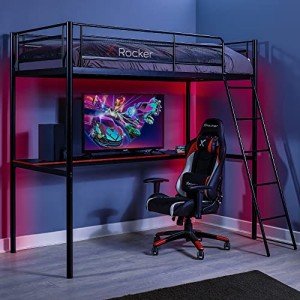Bunk Beds for Kids: A Comprehensive Guide
Bunk beds have been a popular option for kids's bedrooms for many years. They provide a space-saving option that maximizes floor area, provides enjoyable climbing up choices, and comes in a variety of designs that attract kids's imaginations. This article explores the benefits, considerations, styles, and security features associated with bunk beds for kids.
Benefits of Bunk Beds
Bunk beds present multiple advantages that make them an appealing choice for households. Here are some crucial advantages:
Space Saving
- Bunk beds permit two or more children to share a room without sacrificing space for play or other activities.
Cost-efficient
- Buying a single bunk bed can be more economical than purchasing two separate beds.
Enjoyable Factor
- Kids often see bunk beds as an enjoyable place to sleep and play, fostering a sense of experience.
Flexibility
- Bunk beds are readily available in different setups, consisting of L-shaped, loft beds, and even convertible designs that can alter as children grow.
Company
- Many bunk beds feature built-in storage options, such as racks and drawers, helping keep spaces arranged.
Key Considerations Before Purchasing
Before purchasing a bunk bed, it's necessary to consider specific elements, such as:
- Space Requirements
Step the room to guarantee that there suffices vertical space, permitting adequate headroom on the leading bunk. - Age of Your Children
Consider their age and maturity. bunkbedsstore.top advise that children under six need to not sleep in the leading bunk due to security concerns. - Weight Limit
It's important to examine the weight limitations of the bunk bed for both the leading and bottom bunks to ensure security. - Design Preferences
Pick a design that matches the space's design and the kids's preferences. - Material
Bunk beds are offered in various materials, such as wood or metal. Each has its advantages and downsides concerning toughness and aesthetic appeals.
Styles of Bunk Beds
Bunk beds can be found in various styles to fit different aesthetics and practical requirements. Here's a list of some popular designs:
- Standard Bunk Beds
Traditional stacked beds that consist of 2 beds built one above the other. - Loft Beds
A bed raised high off the ground, with space below for a desk, play area, or storage. - L-Shaped Bunk Beds
Two beds organized in an L-shape, offering more floor space and a special style element. - Twin Over Full Bunk Beds
These alternatives feature a twin bed on leading and a full-sized bed on the bottom, accommodating older children or adults. - Triple Bunk Beds
Developed for 3 kids, these beds usually consist of 3 stacked beds, suitable for bigger families.
Security Features to Consider
Making sure the security of children utilizing bunk beds is critical. Here are some safety includes to search for before purchasing:
- Guardrails
A bunk bed should include strong guardrails on the leading bunk to prevent unexpected falls. - Ladders
Ensure that the ladder is firmly connected and easy for children to browse safely. - Stability
Search for bunk beds with lower center of mass and broad bases to provide better stability. - Quality Construction
Choose beds made from durable products that meet safety standards, such as ASTM (American Society for Testing and Materials) guidelines.
FAQs About Bunk Beds
1. What age is suitable for a leading bunk?Generally, kids aged six and older are recommended for sleeping in the leading bunk. 2. Are bunk beds safe for toddlers?Most specialists encourage versus
positioning young children in the leading bunk due to the
danger of falls and inappropriate ladder use. 3. Can bunk beds be separated?Many bunk beds are developed to be separated into 2 standalone beds,
offering included flexibility as kids grow
. 4. How do I preserve a bunk bed?Regularly check for loose screws and use, keep bed mattress tidy, and ensure that the bunk bed is
stable to prolong its life expectancy. 5.
Are there any unique bed mattress requirements for bunk beds?Yes, mattresses for bunk beds must fit comfortably without leaving spaces. Usually, thinner mattresses
(around 6 to 8 inches )are suggested for leading bunks for security. Bunk beds use a flexible, practical, and enjoyable solution for kids's sleeping plans, maximizing space while accommodating numerous kids in one space. By thinking about the important aspects
of design, safety, and space, parents can make a notified choice when choosing the right bunk bed for their kids's requirements. With the best care and upkeep, a bunk bed can be a precious furniture piece that offers years of use and pleasure for kids. Summary Table of Bunk Bed Styles Style Description Best For Standard Bunk Beds Traditional style, two stacked beds Smaller sized rooms Loft Beds Elevated bed with open space below Study or play locations L-Shaped Bunk Beds Two beds in an L-shape
Included floor space Twin Over Full Twin on leading,
| complete on bottom Accommodating older children Triple | ||||||
|---|---|---|---|---|---|---|
| Bunk Beds | 3 stacked beds | Larger families By understanding | the numerous options readily available, designated factors to consider for safety and performance, and suitable age standards, families | can choose the best bunk bed that not | only boosts their home | however also ensures a safe and |
| pleasurable sleeping environment | for their kids.

|
